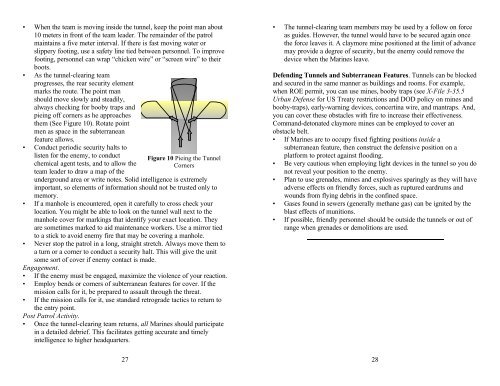Urban Patrolling Tactics, Techniques and Procedures - Defense ...
Urban Patrolling Tactics, Techniques and Procedures - Defense ...
Urban Patrolling Tactics, Techniques and Procedures - Defense ...
Create successful ePaper yourself
Turn your PDF publications into a flip-book with our unique Google optimized e-Paper software.
• When the team is moving inside the tunnel, keep the point man about<br />
10 meters in front of the team leader. The remainder of the patrol<br />
maintains a five meter interval. If there is fast moving water or<br />
slippery footing, use a safety line tied between personnel. To improve<br />
footing, personnel can wrap “chicken wire” or “screen wire” to their<br />
boots.<br />
• As the tunnel-clearing team<br />
progresses, the rear security element<br />
marks the route. The point man<br />
should move slowly <strong>and</strong> steadily,<br />
always checking for booby traps <strong>and</strong><br />
pieing off corners as he approaches<br />
them (See Figure 10). Rotate point<br />
men as space in the subterranean<br />
feature allows.<br />
• Conduct periodic security halts to<br />
listen for the enemy, to conduct<br />
chemical agent tests, <strong>and</strong> to allow the<br />
team leader to draw a map of the<br />
27<br />
Figure 10 Pieing the Tunnel<br />
Corners<br />
underground area or write notes. Solid intelligence is extremely<br />
important, so elements of information should not be trusted only to<br />
memory.<br />
• If a manhole is encountered, open it carefully to cross check your<br />
location. You might be able to look on the tunnel wall next to the<br />
manhole cover for markings that identify your exact location. They<br />
are sometimes marked to aid maintenance workers. Use a mirror tied<br />
to a stick to avoid enemy fire that may be covering a manhole.<br />
• Never stop the patrol in a long, straight stretch. Always move them to<br />
a turn or a corner to conduct a security halt. This will give the unit<br />
some sort of cover if enemy contact is made.<br />
Engagement.<br />
• If the enemy must be engaged, maximize the violence of your reaction.<br />
• Employ bends or corners of subterranean features for cover. If the<br />
mission calls for it, be prepared to assault through the threat.<br />
• If the mission calls for it, use st<strong>and</strong>ard retrograde tactics to return to<br />
the entry point.<br />
Post Patrol Activity.<br />
• Once the tunnel-clearing team returns, all Marines should participate<br />
in a detailed debrief. This facilitates getting accurate <strong>and</strong> timely<br />
intelligence to higher headquarters.<br />
• The tunnel-clearing team members may be used by a follow on force<br />
as guides. However, the tunnel would have to be secured again once<br />
the force leaves it. A claymore mine positioned at the limit of advance<br />
may provide a degree of security, but the enemy could remove the<br />
device when the Marines leave.<br />
Defending Tunnels <strong>and</strong> Subterranean Features. Tunnels can be blocked<br />
<strong>and</strong> secured in the same manner as buildings <strong>and</strong> rooms. For example,<br />
when ROE permit, you can use mines, booby traps (see X-File 3-35.5<br />
<strong>Urban</strong> <strong>Defense</strong> for US Treaty restrictions <strong>and</strong> DOD policy on mines <strong>and</strong><br />
booby-traps), early-warning devices, concertina wire, <strong>and</strong> mantraps. And,<br />
you can cover these obstacles with fire to increase their effectiveness.<br />
Comm<strong>and</strong>-detonated claymore mines can be employed to cover an<br />
obstacle belt.<br />
• If Marines are to occupy fixed fighting positions inside a<br />
subterranean feature, then construct the defensive position on a<br />
platform to protect against flooding.<br />
• Be very cautious when employing light devices in the tunnel so you do<br />
not reveal your position to the enemy.<br />
• Plan to use grenades, mines <strong>and</strong> explosives sparingly as they will have<br />
adverse effects on friendly forces, such as ruptured eardrums <strong>and</strong><br />
wounds from flying debris in the confined space.<br />
• Gases found in sewers (generally methane gas) can be ignited by the<br />
blast effects of munitions.<br />
• If possible, friendly personnel should be outside the tunnels or out of<br />
range when grenades or demolitions are used.<br />
28

















